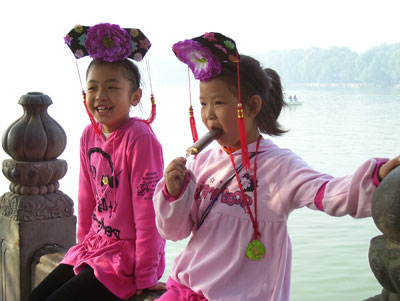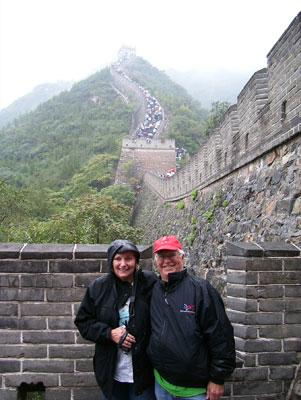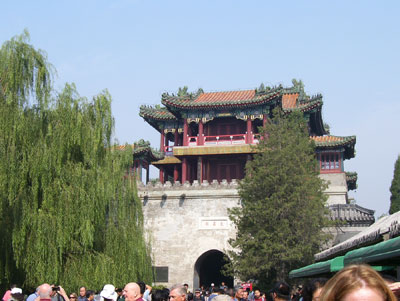A month in China begins in Beijing
by Judy Licata and Marvin Herman, Delavan, WI
Mining the Internet for bargain travel to China, we found a gem in the 29-day “Journey of a Lifetime” tour with China Focus Travel (San Francisco, CA; 800/868-7244, www. chinafocustravel.com). Departing San Francisco, a total of 24 people, none of whom initially believed this trip could be done for the price, would ultimately meet in Beijing.
The basic cost for the tour was $3,900 per person. Adding taxes, visa fees, round-trip air add-on from Chicago ($300) and a night at an airport hotel in San Francisco on the trip back home ($120), our cost was about $4,500 per person. This included accommodations in 4- and 5-star hotels throughout China and six internal flights.
All meals and the services of a national guide plus local guides at each destination within China also were included in the cost. There were almost no add-ons or optional tours requiring additional payment.
Initial observations
Flying westward into “tomorrow,” we arrived in Beijing around 6 o’clock on Oct. 3, 2007. Once in the airport, I found an ATM and got a supply of yuan (about 7.5 to the U.S. dollar) to use for shopping and incidentals.
Incidentally, my ATM card uses the Cirrus system and I would later discover that, except in big-city airports and some large hotels, my card wouldn’t work. The alternative is to take cash advances from credit cards, a more expensive proposition.
Our national guide, Li Xiang Ping (“Toby”), was experienced and spoke excellent English. He took us by bus to the Jiangxi Grand Hotel, where we had a large room with cable TV (only CNN was in English) and air-conditioning. Throughout our trip, beds were extremely hard, by Western standards, but the rooms were large and had Western toilets.
Our first breakfast was very good, but as the tour went on, meals tended to be somewhat repetitive in their content and mediocre in quality. In fact, near the end of the tour, members of the group were seeking out American fast-food chains such as McDonald’s and KFC in order to avoid what we called “spinner dinners,” meals served on tabletop revolving devices, family style.
Most people tolerated the food pretty well, although there were isolated cases of stomach upset and diarrhea.
Getting started
The air quality in the cities we visited was generally poor. A haze, caused by pollution, hung over everything. So was the condition on our first day of touring in Beijing, which included the Summer Palace, where we strolled the grounds and ferried across a lovely small lake. But we were strolling with about two million Chinese tourists who were visiting the city for Golden Week, a celebration of the birth of the People’s Republic of China.
Our tour also included several visits to facilities that, although they had an educational component, were basically shops for which the delivery of tourists provided compensation for the guides. These included a pearl factory, a lacquer furniture factory, a silk factory and a jade factory.
The group was told that the Chinese government required tourist groups to be taken to these shops. Given the length of the tour, no one felt that these visits were a detraction, although some of the group who wished to shop independently and at a lower cost felt the time allocated to each visit was excessive.
Beijing sights
After our tour to the Summer Palace, we visited Tiananmen Square, which was in the process of being prepared with floral displays and topiaries for the 2008 Olympics. The large pictures of Sun Yat-sen and Chairman Mao were familiar, and it was a great place to watch and interact with large numbers of people.
We found the Chinese people extremely friendly and anxious to pose for photos with Americans. Every Chinese person we met, especially the children, knew to say “Hello,” then wait for us to return their greeting.
Our next stop was the Forbidden City, from which emperors ruled for almost 600 years. Visitors cannot go inside the buildings, but if they could there would be nothing to see since most of the contents have been removed and some were destroyed during the cultural revolution. The local guide recounted stories of life in the days of emperors, concubines and eunuchs.
The next day dawned dark and gloomy, as did most days in China. The Great Wall, 4,000 miles long, was our next challenge. My wife and I walked a bit of the wall, finding at various levels stalls of merchants selling all manner of tourist goods. These merchants, and others we encountered in various places throughout China, were extremely aggressive. Visitors need to develop a hard shell for dealing with these folks.
Following a few more sights and a short rest at our hotel, we went out for a Peking duck dinner. Still exhausted from our flight and the day’s touring, we fell into our hard beds and slept so we could be up early for our 4-hour flight to Ürümqi in the west of China.
Interestingly, there are no time zone changes in China. Whatever time it is in Beijing is the time throughout the country.
On to Ürümqi
Ürümqi is the capital of the Xinjiang Uyghur Autonomous Region in northwest China. It is fringed by the Tian Shan Mountains and is bordered by eight countries, from Mongolia in the north to India to the south. Fifty percent of the population is made up of ethnic minorities, including the Uighurs, Kazakhs, Manchus and Tajiks.
We were there for the beautiful scenery, including Heavenly Lake, plus a chance to learn about the minority people and to sample the wine and lively markets. Unfortunately, our local guide, though a likeable fellow, was young and inexperienced and spoke English poorly.
After dinner, my wife, Judy, and I took a short walk a few blocks from the hotel and found a discount bazaar where what seemed like 10,000 people were in a state of frenzied buying, the likes of which we had not seen even in Jerusalem, Istanbul or Cairo. The stereotype of the starving Chinese depicted in post-WWII newsreels was a far cry from this reality. Young people in their teens and twenties were buying jeans, makeup, perfume, purses and shoes, with Gucci knockoff bags on offer for $20. It was an eye-opening experience.
During the entire tour, we felt safe wandering China’s streets without our guides and, though we were cautioned to keep our cash and passports safe from pickpockets, no one experienced any threats of that or any other kind.
Driving across town to the Uighur (an Islamic minority) section, we thought we had been transported to a different world within the already different world that is China. We walked streets where flat breads were being baked in outdoor ovens. Women in Islamic dress were shopping at outdoor butcher shops where the meat hung on hooks. There was all manner of trade and commerce typical of a town on the Silk Road, much as it must have been thousands of years ago.
Toward Xi’an
Continuing through the Gobi Desert, we stopped in the city of Turpan (Turfan) before catching an overnight train to Dunhuang, a prosperous city in the Gansu Province. We were visiting Dunguang primarily to see the art of the Mogao Caves, the most extensive and well preserved in China.
Then we took a 5½-hour bus ride from Dunhuang to Jiayuguan, a hamlet of a mere 180,000 people. One purpose for this stop was to see the nearby Han tombs, an example of a wealthy citizen’s burial chamber, decorated with drawings of daily life as it existed in the early sixth century.
The tomb, laid out in three sections, required me to bend deeply at the waist to get from room to room. Each of the rooms was rather small, and as our local guide explained each drawing I got a bit claustrophobic and ducked out early. Each tomb is far underground and reached by stairs.
From Jiayuguan we flew 1½ hours to Xi’an, a town in the Shaanxi Province that fronted the Silk Road 800 years ago. That night we had the Qin Dynasty Dumpling Dinner, served up by waiters bearing high stacks of steamers, each carrying a different kind of dumpling — fish, meat, vegetable — about 20 in all. It was very tasty!
The next afternoon was devoted to viewing the terra-cotta army, discovered in 1976. It is an amazing find and was very impressive although not worth the six hours we devoted to it.
At this point in the tour, about half the group was suffering from some sort of illness, mostly coughing. If one has ever had respiratory problems, careful consideration should be given to whether this trip is appropriate or not. We had been in polluted cities, sandy deserts, damp caves and dusty museums, and some people were talking about flying home.
Next month, the journey continues.





